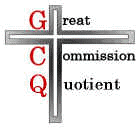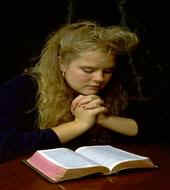Robertson McQuilkin, President Emeritus - Columbia International University

Excerpt from WHAT IS
YOUR GCQ?
Robertson McQuilkin,
President Emeritus - Columbia International University 
For thirty years I've cris-crossed the country, evaluating the GCQ (Great Commission Quotient) of churches. Of course, the churches I visit have a pretty good GCQ rating--otherwise they wouldn't invite me in for an evaluation! After a while, a person begins to get a feel for what a true "Great Commission" church is. Of late the data have come together in sort of a formula, the 5-10-50-100 formula, to be exact.

Some years ago church growth analysts concluded that, in most communities
in America, a church ought to have a five percent
conversion growth each year--not transfer, not children of the
church, but baptisms of new believers. A little reflection will show how
unlikely that formula is. A five percent growth rate might be rather slow for a
church of ten people, and, in contrast, would truly be remarkable for a church
of 10,000. At least it cannot continue at five percent indefinitely or the whole
world would become one congregation! The Yoido Full Gospel Church in Seoul may
seem to be headed in that direction, but even David Yonggi Cho has some limits.
Nevertheless, the point is clear. If a church has members who live authentic
Christianity, most of whom faithfully witness, and few who have the gift of
evangelism, then that church will see substantial growth in new converts. So the
first evaluation is this: How many baptisms of new believers did your church
have last year? What percentage of the membership is that? Does that satisfy
you? Does it satisfy God? Does that qualify your church as a Great Commission
church, fully obedient to Christ's last command? Perhaps it's time to set a
faith goal--the number of converts you're asking God to give in the next year,
in the next five years. Of course faith without works is dead, so it must also
be time to set plans in motion to achieve that goal.


 The
church at Jerusalem is a wonderful model to follow. That first year at least
they beat the "5 percent formula" by a fair margin --5,000 baptisms in
a few weeks following start-up! Furthermore, they were models of prayer, of
Spirit-anointing, of race relations, of care for the poor, of godly and wise
leadership. Yet there was one thing they weren't good at --obeying Christ's last
command to go into all the world. God had to send persecution to get them moving
and even then they didn't venture very far. But Antioch --that's another story!
They were so in tune with the Spirit that when he spoke to them in a prayer
meeting, they immediately sent off their senior pastor and his top associate in
the first recorded pro-active missions thrust--that's twenty percent of their
pastoral staff.
The
church at Jerusalem is a wonderful model to follow. That first year at least
they beat the "5 percent formula" by a fair margin --5,000 baptisms in
a few weeks following start-up! Furthermore, they were models of prayer, of
Spirit-anointing, of race relations, of care for the poor, of godly and wise
leadership. Yet there was one thing they weren't good at --obeying Christ's last
command to go into all the world. God had to send persecution to get them moving
and even then they didn't venture very far. But Antioch --that's another story!
They were so in tune with the Spirit that when he spoke to them in a prayer
meeting, they immediately sent off their senior pastor and his top associate in
the first recorded pro-active missions thrust--that's twenty percent of their
pastoral staff.
I've been in a few churches like that! The first time I visited Calvary Church in Lancaster, Pennsylvania, I asked the pastor how many missionaries they supported. "One hundred eighty," he answered. "How many are from this church?" I inquired. "All of them" was his unhesitating response. With 1,800 members it wasn't hard to figure out: or a tithe of the membership. Perhaps the most Antioch church I've seen is Faith Bible Church of Sterling, Virginia. I could 10 percent, see immediately they were into evangelism. With only 270 local members in that young church, they had 600 in attendance, many of them seekers from the Washington, DC international community. They weren't merely reaching their own "Jerusalem"--they had a vision for the world. Still I wasn't prepared for the total when I asked how many missionaries they had sent out. "Seventy," they told me. That's twenty percent, not of the pastoral staff, like Antioch, but rather, twenty percent of the membership. Incredible! Just like the Moravians who launched the modern missionary movement.
That's a bit much, I suppose. There's no danger of it happening, but if every church followed Faith Bible Church's example, it would take some pretty heroic sacrifice on the part of members-at-home to support such a task force. For a standard, I suggest half of that --10 percent --as a gold-medal performance. How is it at your church? 1% 2% 5% 0% Is it time to set a faith goal and step up one percentage point?


I've seen many gold medallists in the "50" category, but only once
have I seen a 75. When I meet a missionary in some distant part of the world and
inquire about their roots, often I hear "Norfolk." Then I know they
found Christ or heard the missionary call at the Norfolk Tabernacle Church.
There's a church that obeys the Great Commission! A constant stream of US Navy
personnel find Christ in the Tab and fan out across the world to serve him. But,
following my first visit many years ago, I was  startled to discover in their
annual report how they supported those missionaries.
Seventy-five percent of their income was invested away from the home church!
Meeting for decades in a wholly inadequate set of buildings, they refused to cut
back on their investment in reaching the rest of the world.
startled to discover in their
annual report how they supported those missionaries.
Seventy-five percent of their income was invested away from the home church!
Meeting for decades in a wholly inadequate set of buildings, they refused to cut
back on their investment in reaching the rest of the world.
That's the only church I've seen that gave 75 percent, but many churches reach the 50 percent level and that seems appropriate --half for "us" and half for "them." How is it at your place? % of total gift income is invested in missions. Would God be calling you to a 10% increase? Perhaps it's time to reorder your priorities and take a leap of faith!



Right up front I admit that I've never seen a church meet this standard, though
I still believe it's a biblical one. I've been to one church that comes close.
The most important part of the missionary enterprise is prayer, we would all
concede, and I remain convinced that 100% of true
disciples ought to be involved in praying for the world and for those sent to
reach that world --through individual and family prayer, which the
church may not be able to measure, and through group prayer, which we are able
to measure.
In Martinez, Georgia a group of pastors from many denominations gathered to
think about missions in the local church. I related my experience of serving as
consultant in dozens of churches to help them evaluate their missions program.
One striking similarity among churches, I informed my listeners, was that the
average time spent in some form of group prayer for missions, including  prayer
for their own missionaries, totaled a mere three minutes per week. Then I
directed my question to the pastors sitting there. "How is it in your
church?" Pastors from one denomination agreed that in actuality it amounted
to only one minute of prayer per week. A leading pastor from another
denomination that prides itself on a strong missions program suggested that the
dozens of churches he ministered in probably averaged five minutes a week. A
missionary, fresh from visiting many churches of his denomination (perhaps the
fastest growing church both domestic and overseas), reported that the average
was probably a scant 30 seconds. (That's cutting the "missionary
minute" in half!) One pastor admitted that in his churches there was no
prayer time for missions.
prayer
for their own missionaries, totaled a mere three minutes per week. Then I
directed my question to the pastors sitting there. "How is it in your
church?" Pastors from one denomination agreed that in actuality it amounted
to only one minute of prayer per week. A leading pastor from another
denomination that prides itself on a strong missions program suggested that the
dozens of churches he ministered in probably averaged five minutes a week. A
missionary, fresh from visiting many churches of his denomination (perhaps the
fastest growing church both domestic and overseas), reported that the average
was probably a scant 30 seconds. (That's cutting the "missionary
minute" in half!) One pastor admitted that in his churches there was no
prayer time for missions.
The representative from nearby Augusta First Presbyterian Church didn't speak. Since he was reluctant, I relayed his story. When their pastor came twenty years earlier, there was no prayer for missions, and precious little prayer for anything else. In fact, not one elder could or would pray in public. That historic church gave token financial support to one missionary, but no one knew exactly who she was, except that she wasn't from among them. Little by little the pastor led his people to become a praying people so that today prayer pervades the atmosphere. And each Sunday night for an hour before the evening service --which is a packed house --hundreds gather in "prayer bands" to pray for the world and for their dozens of representatives in Asia, Europe, Africa, and South America. It won't surprise you to learn that such a praying church is filled with new-born believers, and that in a recent missions conference, thirty new volunteers stepped forward for career missionary service, including many professionals, and this year again more than fifty percent of their budget is designated to missions. No one would claim that 100 percent of the members pray for missions, and God only knows what that percentage is. But Augusta First Presbyterian is certainly headed in the right direction: on their knees! Do you have a feel for the percentage of individuals and families in your church whom you believe are praying regularly for your missionaries and for the cause of world evangelism? How much prayer time each week does some group within the church or the church as a whole devote to missions? Do you need to make plans to change that?
There you have it: 5-10-50-100. This need not be a formula for frustration and guilt, but rather, a realistic gauge reminding us to raise our Great Commission Quotient. if God is calling some of you to faith action that will raise your GCQ just one point, listen carefully and act boldly! To participate more fully and ardently in completing his plan for world evangelization --what could be a greater joy!